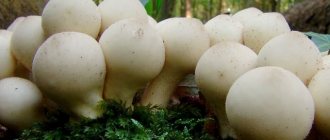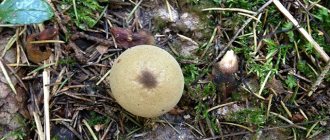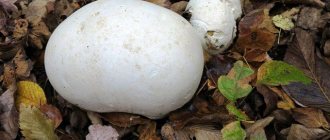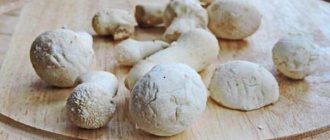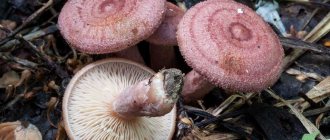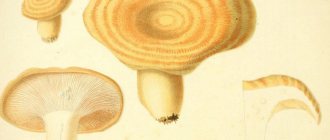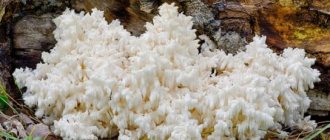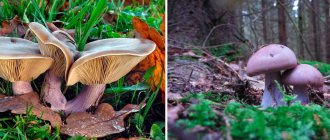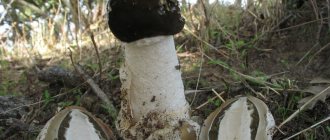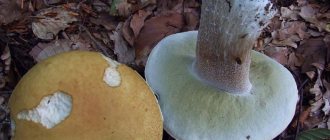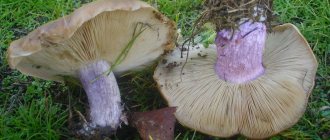Raincoat (lat. Lycoperdon) is a genus of mushrooms of the Champignon family. Also known as pearl or real raincoat. Popularly, mature specimens are called:
- tobacco mushroom;
- flutter;
- dust duster;
- wolf tobacco;
- grandfather's tobacco;
- wolf tobacco.
This type of mushroom received its popular name for its property of smoking when pressed.
Young fruiting bodies are called bee sponge or hare potato.
Botanical description
In the raincoat, the cap and stem form one fruiting body. It, depending on the type, reaches different sizes and weights: from several grams to two kilograms. Shape: round, ovoid or pear-shaped. The surface of the dust mole may be white, grayish-white or yellow, and is sometimes strewn with warts or small spines. The white pulp, as it ripens, dries out and transforms into a dark spore powder, which is released through a hole in the top of the mushroom and spreads through the air. The body of an adult tobacco mushroom is covered with a two-layer shell. The inner shell is leathery, and the outer shell is smooth.
Edibility
The puffball is an edible mushroom, but due to its individuality, there are some things to consider:
- If the cut flesh has a yellow or green tint, then such a mushroom is not suitable for eating. It should be dense, pure white, uniform and elastic.
- Only young mushrooms need to be collected. This representative of the mushroom kingdom is aging quickly. And such fruiting bodies are no longer suitable for consumption.
Edible types of puffballs:
- Giant. The giant or bighead (Langermannia gigantea) is a huge ball, but sometimes can be slightly flattened. Weight can reach 8 kg. Covered with smooth or flaky skin. In an adult mushroom, the color changes from white to dirty green. The pulp is crumbly. This is a rare species and is not often found in the middle zone. Grows in meadows, fields or old pastures; can be found in deciduous forests.
- Pear-shaped (Lycoperdon pyriforme). The name comes from the shape of the fruiting body, which looks like a pear. Its thick part reaches about 7 cm in diameter and about 5 cm in length. The young milky body is covered with a double membrane, from which a small false stalk extends. The outer layer is spinous and covered with cracks or scales. In an adult mushroom, the thorns fall off and this layer begins to crack. The inner gray-brown or yellowish shell opens, which covers the spores. They penetrate through holes on the top of the puffball after maturation.
- Spiny (Lycoperdon perlatum). Also known as pearl, hedgehog or needle. The shape is pear-shaped, slightly flattened. They grow from 2 to 7 cm in diameter and up to 4 cm in height. The skin is covered with small spines or warts. Initially white, and over time - gray and purple-brown, which is already a sign of unsuitability for food. The harvest begins in early July and ends in early September.
- Elongated loggerhead (Calvatia excipuliformis). Outwardly it resembles a bubble, pulled to the bottom. It looks smooth, but upon closer inspection you will notice that it is covered with inconspicuous, delicate, thin spines. The flesh of a young mushroom is white, while that of an adult is dark, sometimes almost black. Mushroom pickers are often confused with false puffballs due to the combination: the absence of a pseudopod and the presence of needles.
- Meadow puffball (Lycoperdon pratense or Vascellum pratense). White spherical shape, which flattens and turns brown over time. Small sizes from 1 to 6 cm in diameter and from 1 to 5 cm in height. Has a wrinkled pseudopod. It grows mainly on forest edges, meadows and clearings. Use only at a young age.
In addition to edible species, there are also false ones:
- Warty puffball (Scleroderma verrucosum). The poisonous representative of the tuberous form is yellowish-gray, and over time light brown, with hard and thick skin. Up to 5 cm in diameter. Characterized by the complete absence of a stalk. The aroma together can be compared to the smell of raw potatoes and herbs.
- Common or orange puffball (Scleroderma citrinum). Fruit body up to 6 cm in diameter. Shape: tuberous, smooth. The shell is thick, dirty yellow or brown in color with small scales in the upper half of the mushroom. The flesh is white, but when ripe it turns black with white fibers. The smell can be compared to a truffle.
- Spotted, panther or leopard scleroderma (Scleroderma areolatum). Pear-shaped or spherical mushroom. The diameter is from 1 to 5 cm. The leg is missing. The skin is smooth and thin. White or cream color, at a more mature age it changes to brownish-yellow. The leopard pattern is created by small scales scattered over the surface, with characteristic rims. The white flesh, as it ripens, changes to greenish-brown or dark purple with white streaks. The smell is sweet.
The benefits of pigs
The benefits and harms of pigs are discussed by specialists in various fields quite often. This type of mushroom is poisonous, but if used correctly it will not cause harm. The benefits of pork are the same as those from eating edible varieties of fruiting bodies. They are also rich in vitamins, amino acids and proteins, and contain a large number of microelements: magnesium, phosphorus, potassium, etc.
There is no danger in consuming such forest gifts if they are prepared correctly. They will not lead to poisoning or other consequences if:
- Clean them within the first hour after collection.
- Soak the peeled fruiting bodies for 24 hours in a saline solution with citric acid (this is important for removing poisons and heavy metals from the product).
- Rinse the soaked mushrooms under running water and boil in salted water for 5-7 minutes.
The svinushka mushroom is dried and then prepared as desired: stewed with meat and vegetables, included in first courses, pickled or added to salads. Svinushka mushrooms are also prepared for the winter. But it’s better not to risk it and leave them to grow where you saw them.
Useful properties and contraindications
Raincoat has long been used not only in folk, but also in official medicine for its medicinal properties.
It contains:
- chromium;
- calcium;
- sodium;
- iodine;
- potassium;
- fluorine;
- phosphorus;
- iron;
- zinc;
- rubidium.
- molybdenum.
The mushroom pulp contains amino acids:
- cystine;
- methionine;
- tryptophan;
- phenylalanine.
Beneficial features:
- improves the cardiovascular system;
- cleanses the body and removes radionuclides and toxins;
- increases immunity;
- hemostatic;
- has antitumor properties;
- improves the body's metabolic processes;
- has a beneficial effect on the skin, making it elastic and healthy.
Broths and infusions from young fruiting bodies are used:
- at elevated temperature;
- with high blood pressure, angina pectoris;
- to relieve inflammatory processes, for example, with throat bumps, chronic tonsillitis or severe pain in the kidneys;
- to reduce hemoglobin;
- to inhibit the growth of malignant tumors and the progression of leukemia;
Not recommended for pregnant and lactating women and children under 5 years of age. Take with caution in case of diseases of the pancreas, kidneys and exacerbation of diseases of the gastrointestinal tract. You should not collect mushrooms in areas with poor ecology, near factories and highways, as they may contain toxins and pose a health hazard.
Why are mushrooms dangerous?
0
Source:
The lectin toxin contained in pigs, entering the blood, provokes the decomposition of red blood cells, thereby causing hemolytic anemia, if the dose is small, then nephropathy, jaundice and even kidney failure in acute forms. Particularly high sensitivity to poison in children and people after illness. Mushrooms are dangerous if a person has urolithiasis and a tendency to allergies. It is also reported that muscarine, a specific alkaloid found in red fly agarics, was also found in Solokha. In large quantities it causes vomiting, diarrhea, poisoning, bradycardia, and visual impairment. In especially severe cases, it leads to breathing problems and pulmonary edema. Promotes drug addiction. However, the effect of the toxin is not as obvious as, for example, in the toadstool. Poisoning can occur over a fairly long period of time, it all depends on the number of mushrooms, their age and the condition of the body. In addition, the mushroom is an accumulator of radioactive isotopes, especially cesium and copper, which are very dangerous to health
Storage and preparation
After collection, place it in a cold place, so the mushroom will not lose its beneficial properties for 1-2 days. To increase shelf life, it can be frozen by cutting it into small pieces. It can remain in this form for up to 6 months.
When dried or salted, the shelf life increases to 12 months. Young representatives of this genus of mushrooms can be cooked without prior boiling.
Before frying, boil the puffballs for about 10 minutes. And when consumed boiled, for complete readiness, boil for at least 15 minutes.
You can prepare raincoats safely and tasty using various recipes. The main thing is to collect only young mushrooms, having previously cut the fruiting body to ensure the white flesh and edibility of this specimen.
Signs of poisoning
Svinushka mushrooms were previously considered edible, because signs of poisoning did not always appear. The reason is the different individual sensitivity of people to heavy metals and poisons contained in fruiting bodies.
The greatest harm was suffered by people with health problems or children, since some have not yet fully developed immune systems, while others have it weakened due to health problems. After consuming the mushroom for 1-3 hours, symptoms do not appear. Later, people start to worry:
- nausea;
- vomit;
- stomach ache;
- diarrhea;
- yellowness of the skin;
- dizziness.
In case of poisoning, an increase in hemoglobin in the urine is observed. Kidney activity is also impaired. Urination becomes rare, and there is a risk of oligoanuria.
Bee venom in the treatment of cancer
Bee venom has been studied for cancer; melittin is considered cytolytic but nonspecific. Melittin can disrupt the lipid bilayer of the membrane and exhibits toxicity when administered intravenously. APi M has the ability to suppress tumor growth in breast, liver, prostate and lung cancer cells. In vitro and in vivo studies indicate that melittin can suppress cancer cell growth by inhibiting NF-κB signaling and activating caspase 3 and 9 pathways. Inhibition of hepatocellular carcinoma cell motility has been observed in vitro and in vivo through inhibition of Rac1-dependent pathways.
The body's response to bee venom
Bee venom therapy may alleviate immune diseases. Bee venom secretory phospholipase A2 exhibits in vitro and in vivo activity in the immune system and is used to treat asthma, Parkinson's disease, and drug-induced organ inflammation. Immune reactions to bee venom can be dangerous when highly elevated, but when controlled, allergic immunity can be beneficial in human defense to stimulate type 2 immune responses. Type 2 immunity is mainly based on barrier defense, and these responses are initiated by T helper type 2 (TH2), immunoglobulins E and G1 (IgE and IgG1), antibodies and other components of the innate immune system (epithelial barriers, innate lymphoid) cells - ILC , eosinophils, mast cells, basophils and activated macrophages). The innate immune system senses venom components, inducing a protective immune response against antigens through pattern recognition receptors (PROs), such as Toll-like receptors found on pathogen-associated molecular patterns (PAMPs).
The anti-inflammatory properties of bee venom can suppress the activity of inflammatory antigens, reduce the number of infiltrated inflammatory cells, and suppress the expression of (TNF)-α, IL-1β, Toll-like receptor (TLR) 2, and CD14 expression. , inhibiting the binding activity of nuclear factor-κB (NF-κB) and activator protein (AP)-1. The major allergen of Bet V 1, PLA2, stimulates the innate immune system by binding to PRRs, such as Toll-like receptors, which recognize PAMPs, inducing a type 2 immune response. PLA2 in BV induces T helper 2 (Th2) cell type responses and group 2 innate lymphoid cell (ILC2) activation through enzymatic degradation of membrane phospholipids and secretion of IL-33. PLA2 induces IgE production, protecting against future allergic/immunological reactions in the event of a lethal dose of bee venom; PLA2 plays a critical role in human defense by enhancing Th2 differentiation, ILC2 activation, immunoglobulin production, membrane remodeling, and anti-inflammatory responses.
Anti-inflammatory potential of bee venom
Low doses of bee venom produce a range of anti-inflammatory responses that have been studied in diabetes, rheumatoid arthritis (RA), heart disease, obesity, asthma, skin diseases and diseases associated with the central nervous system (Alzheimer's disease, Parkinson's disease, etc.) sclerosis). Bee venom suppresses inflammatory cytokines, including interleukin-6 (IL-6), IL-8, interferon-γ (IFN-γ), and tumor necrosis factor-α (TNF-α). Reductions in signaling pathways responsible for the activation of inflammatory cytokines, nuclear factor-kappa B (NF-κB), extracellular signal-regulated kinases (ERK1/2), protein kinase Akt, and human Porphyromonas gingivalis lipopolysaccharide (PgLPS) keratinocytes are associated with melittin treatment (65 ) (Fig. 2).
Pharmacodynamics of bee venom components
Bee venom contains enzymes (phospholipase A2 (PLA2), phospholipase B, hyaluronidases, acid phosphatases, acid phosphomonesterases, α-D-glucosidases and lysophospholipases); peptides (lytic peptide melittin, apamin, degranulating peptide of mast cells (mast cells), secapin, pamin, minimin, procamine A, B, protease inhibitor, trettiapine, cardiopep and adolapine); and amino acids include g-aminobutyric acid and a-amino acid. Non-peptide components include amines (dopamine, histamine, norepinephrine, neurotransmitters), carbohydrates (glucose, fructose), pheromones (isopentyl acetate; n-butyl acetate; isopentanol; n-hexyl acetate; n-octyl acetate; 2-nonanol; n-decyl acetate; benzyl acetate; benzyl alcohol; and (2) -11-eicosen-1-ol).
Bee venom has been shown to have anti-inflammatory, antinociceptive, antioxidant and anti-apoptotic properties and has been shown to alter gene expression and fibrosis. Side effects include pro-inflammation (higher doses of PLA2, mast cell degranulating peptides, hemolytic compounds (melittin)), allergic reactions to protease inhibitors and peptides, anaphylactic reactions and death.
Multiple protein allergens in bee venom are responsible for the allergic reaction. Allergic reactions can occur in the respiratory system, gastrointestinal tract, cardiovascular system, skin from bites and can lead to severe anaphylactic shock, sometimes leading to cerebral or myocardial ischemia. The non-immune-mediated mechanism of bee venom allergy involves the production of the mediators bradykinin (BK), which leads to anaphylaxis as a result of activation of PLA2 by melittin (mimicking BK).
The potential of bee venom against coronavirus
The development of adjuvant therapies (using APi M and PLA2) for use against SARS-CoV-2 infections offers a unique approach to viral therapy. The development of a DC-based bee venom vaccine using APi M and bvPLA2 opens new opportunities for additional medical interventions against SARS-CoV-2 infections. Research examining cellular signaling between the bee venom proteins Janus kinase (JAK) and activator of transcription (JAK-STAT) will help strengthen its use in complementary medicine against SARS-CoV-2. JAK inhibitors are associated with improved prognosis in patients with COVID-19, but studies are needed to elucidate the cellular mechanisms. Synergistic activity through combinations in alternative and complementary medicine will help combat side effects associated with current monotherapies for treating SARS-CoV-2 infections. SARS-CoV-2 is a new virus, and new treatments may be needed to support treatment over time, which may be important for supporting the immune response in patients suffering from so-called long COVID.
Read more
